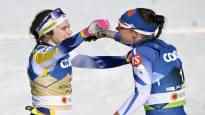Planica World Cup skiing on channels 22.2.–5.3.2023. See the program and broadcast information of the World Ski Championships at this link.
Get in with the facts.
The Finnish team arrived at the World Cup in Planica with a team in which five athletes had reached the podium in the World Cup during the current season.
Out of five Johanna Matintalo suli completely melted in the traditional sprint on the opening day of the World Championships on Thursday. On Friday, he defended the Olympic bronze medal in the combined competition Iivo Niskanen did not excel in the traditional section as expected and was 13th in the final results.
Defending the World Championship silver in the combined normal hill on Saturday morning Ilkka Herola already squatted on the hill section. Herola has always given the top a handicap in jumping skills, the role of which will only be emphasized when moving to suurmäki next week.
Saturday’s second Finnish sport, the women’s combined competition, included those who showed podium pace in the World Cup Kerttu Niskanen and Krista Pärmäkoski World Cup opening.
At no point did Niskanen lose sight of the bronze medal, which was eventually separated by eight seconds. Pärmäkoski finished sixth, half a minute after Niskanen.
An excellent trendsetter
In the case of both Niskanen and Pärmäkoski, the combined competition that usually opens the value competition season has been an excellent indicator over the years, when looking at what can be expected from the competitions later.
When the combined race, which is the second distance, has passed, the ranking in the main distance has usually increased.
Kerttu Niskanen
Krista Pärmäkoski
In this sense, the Finnish bench sports people have enough to be excited about next Saturday. At that time, we ski the main route of Niskanen and Pärmäkoski, a 30-kilometer traditional way of skiing together.
However, the women’s combined competition showed that Kerttu Niskanen’s dream of a 30 kilometer gold medal is very slim. I saw this despite the fact that Niskanen said that he fell before Saturday’s start and that he competed with pain.
At the moment, however, one stands above the rest.
When Therese Johaug left the scene at the end of last season, several women were trying to fill the power vacuum left by the Norwegian. Especially the experienced Niskanen and Pärmäkoski, who had experienced this, lived from this golden dream by Marit Björgen than Johaug’s reign that lasted more than a decade.
Based on Saturday, however, it seems that only the duller precious metal is still available.
Swedish Ebba Andersson on Saturday, he gave a jouhaugma-like performance, where he could afford to fall on the downhill in the middle of the free section. Andersson’s margin of victory to its lowest to Frida Karlsson it was still 22 seconds.
When Andersson has been on the starting line this season, the others have been ringing. Compared to others, the Swede’s fitness curve has only continued to rise as the World Cup approaches.
At the World Championships in Planica, you will be able to compete athletically under significantly more equal conditions than, for example, at the Beijing Olympics a year ago.
At that time, the teams’ preparation was messed up by China’s extreme corona policy. Compared to the previous games of the season, the high altitude of the ski resorts added spice.
There is no information about either of these variables in Planica. And it shows in the results lists: the winners and medalists have mainly followed the results lists of the World Cup season.
Gold requires a miracle
25-year-old Andersson is currently in a class of his own. Without health problems and maintenance failures, he will with a high probability win three more championships: the split start, relay and 30 kilometers.
If Sweden’s maintenance was in big trouble two years ago at the World Championships in Oberstdorf, in Planica, the balance of the Swedish women from two competition trips is a quadruple and a double win.
If more than one team were allowed to compete in the merit races, a completely relevant option would be that all the medal positions in the women’s pair sprint on Sunday would be for the blue and yellow.
Based on what we have seen, it is pointless to count on the failure of Swedish maintenance.
Although Niskanen probably gave an equalizer on the health side on Saturday, his ski skills also do not play into his bag in Planica’s fast descents.
Niskanen needs a miracle to be able to beat Andersson in 30 kilometers in a week. And then Karlsson would have to be beaten.
When you add to this that there are enough questions surrounding Iivo Niskanen, known as the blue and white medal machine of prestigious competitions, in general one Finnish medal in Planica can be considered a work win.
